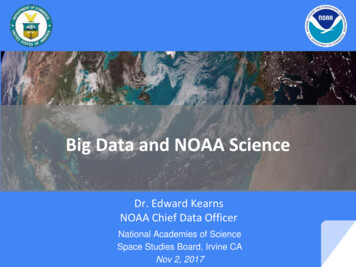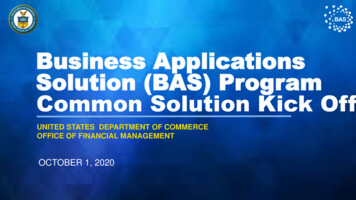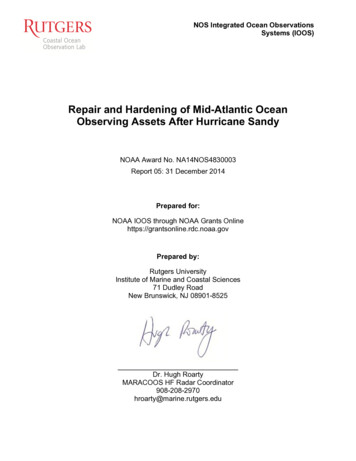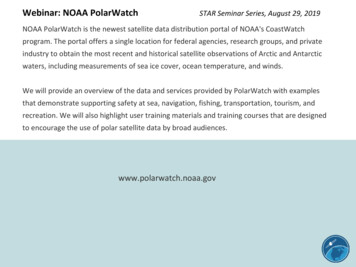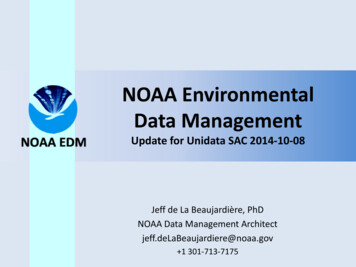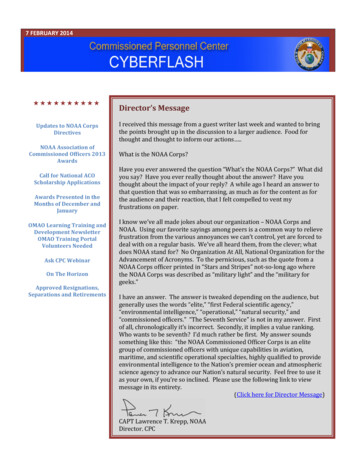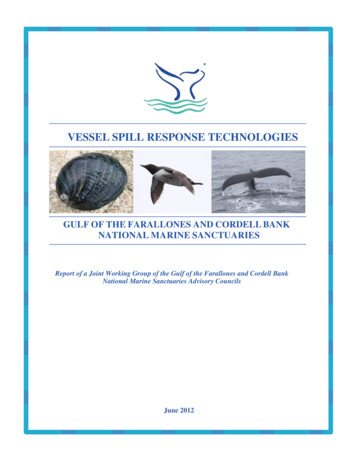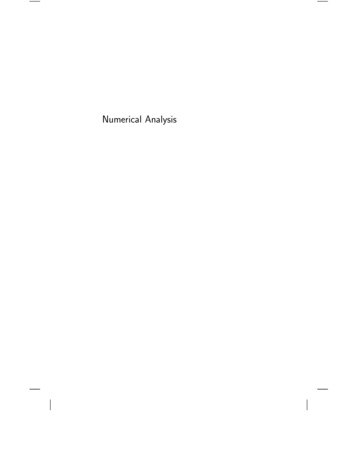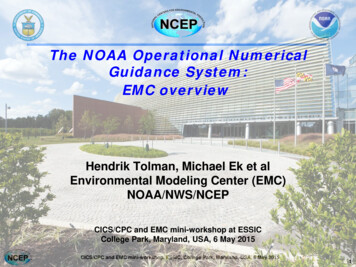
Transcription
The NOAA Operational NumericalGuidance System:EMC overviewHendrik Tolman, Michael Ek et alEnvironmental Modeling Center (EMC)NOAA/NWS/NCEPCICS/CPC and EMC mini-workshop at ESSICCollege Park, Maryland, USA, 6 May 2015CICS/CPC and EMC mini-workshop, ESSIC, College Park, Maryland, USA, 6 May 20151
Outline NCEP and EMC Production Suite Components:o Data Assimilationo Global Forecast System (GFS), Global Ensemble (GEFS)o Unified Global Coupled System (medium-range toseasonal)o North American Multi Model Ensemble (Seasonal)o North America Mesoscale (NAM) model, Hurricane(HWRF), Short-range Ensemble Forecast (SREF)o Hurricane, Land-Hydrology, Ocean, Sea-iceo NOAA Environmental Modeling System (NEMS) NCEP/EMC Model Evaluation Group (MEG)CICS/CPC and EMC mini-workshop, ESSIC, College Park, Maryland, USA, 6 May 20152
National Centers for Environmental PredictionSpecialized Services – Common Mission6 NOA Corps Officers NHC: BrinkleyEMC: OstapenkoOPC: Schultz (Phillips)AWC: WaddingtonSWPC: HemmickOD: OdellNCEP Central OperationsCollege Park, MD(Supercomputers inReston & Orlando)EnvironmentalModeling CenterCollege Park, MDClimate Prediction CenterCollege Park, MDAviation Weather CenterKansas City, MOOcean Prediction CenterCollege Park, MDSpace WeatherPrediction CenterBoulder, COStorm Prediction CenterNorman, OKNational Hurricane CenterMiami, FLWeather Prediction CenterCollege Park, MDMission: Reliable, timely, and accurate analyses, guidance, forecasts,and warnings for the protection of life and property and theenhancement of the national economy.Vision: Nation’s trusted source, first alert, and preferred partner forenvironmental prediction services.EMC: Enhancement, transition, and maintenance of numerical modelsthat provide operational guidance.CICS/CPC and EMC mini-workshop, ESSIC, College Park, Maryland, USA, 6 May 20153
21 GFS MembersNorth American EnsembleForecast SystemGEFS, Canadian Global ModelNorth American LandSurface Data AssimilationSystemOcean onal BaysESTOFS Great Lakes (POM) N Gulf of Mexico (FVCOM) Columbia R. (SELFE) Chesapeake (ROMS) Tampa (ROMS) Delaware (ROMS)ADCIRCRegional NAMNMMBNoah land modelDispersionHYSPLITShort-Range EnsembleForecast 21membersWRF (ARW NMM)NMMB 7members eachAir QualityCMAQHigh Res WindowsWRF-ARW & NMMBNEMS Aerosol GlobalComponent (NGAC)SpaceWeather3D-VARDAGlobal Ensemble ForecastSystem (GEFS)GFDLWRF-NMMWavesWaveWatch IIIRapid Refresh3D-VARDAGlobal ForecastSystem (GFS)Global SpectralNoah LSMRegionalHurricane3D-VARDAGFS, MOM4,GLDAS/LIS/Noah, SeaIce3D-VARDAClimate ForecastSystem (CFS)3D-En-VarDA3D-VARDANOAA’s Operational NumericalGuidance Suite (Feb 2015)High-Res RR (HRRR)WRF ARWWRF ARWGFS & GOCARTENLILUSA, 6 May 2015Noah Land Surface CICS/CPCModel and EMC mini-workshop, ESSIC, College Park, Maryland,4
Data Assimil. Plans: Next GlobalImplementation ( Dec. 2015) Hybrid 4D EnVar: Hourly time bins (7 time levels per analysis). 80 ensemble members. T1534L64 deterministic with T574L64 ensembles used for T574 analysis increments Modified thinning of data in time.Observation changes:– Cloudy Microwave Radiances: Cloud analysis impacted by covariances from Hybridand cloud impacted microwave radiances.– Upgraded CRTM2.2.– Additional aircraft and AMV data.– Bias correction of aircraft temperature observations.NSST:– Variation in Near Sea-Surface Temperature of ocean included in both forecast modeland analysis.– Directly uses radiances and accounts for depth of observations in NSST analysis.– Diurnal cycle of Ocean and observations accounted for much better.CICS/CPC and EMC mini-workshop, ESSIC, College Park, Maryland, USA, 6 May 2015John Derber5
Global Model PlansQ2FY15 implementation (January 14, 2015) T1534 Semi-Lagrangian ( 13km) Use of high resolution daily SST and sea ice analysis High resolution until 10 days Physics:- Radiation modifications- Reduced drag coefficient at high wind speeds- Stationary convective gravity wave drag- Soil Moisture climatology from CFSv2- Changes to roughness length calculationsFY16 NEMS 4D-Hybrid EnVAR Convective upgrade Land and surface layer upgradeFY17 T1534L64 – T1534L128 Enhanced physicsAerosol prediction – initially lower resolution used as forcing in high res.WAM – Whole Atmosphere Model – initially lower resolution up to 600kmCICS/CPC and EMC mini-workshop, ESSIC, College Park, Maryland, USA, 6 May 2015Mark Iredell6
Global Ensemble PlansCurrentNext GEFS Configuration (v11.0.0)ModelGFS Euler model (V9.0.1)GFS Semi-Lagrangian model (V10.0.0)Horizontalres.T254 ( 52km) for 0-192 hours, T190( 70km) for 192-384 hrsTL574 ( 34km) for 0-192 hours, TL382( 52km)for 192-384 hrVertical res.L42 hybrid levelsL64 hybrid levels to match GFS and DACompute84 nodes ( post process) for 55 minutes300 nodes (first 35 minutes), 250 nodes (2nd30 minutes)Outputevery 6-hr for 1*1 degree pgrb filesevery 3-hr for 0.5*0.5 degree pgrb filesScheduleFeb. 2015 – deliver codes/scripts to NCOApr. 2015 – implementation (WCOSS-phase II) Increase model resolution and membership. Introduce other stochastic schemes:- Stochastic Kinetic Energy Backscatter (SKEB) represents processes absent from model.- Stochastic Perturbed Physics Tendencies (SPPT) designed to represent the structuraluncertainty (or random errors) of parameterized physics. Biggest impact for tropics.- Stochastically-perturbed boundary layer HUMidity (SHUM) designed to representinfluence of sub-grid scale humidity variability on the the triggering of convection.- Stochastic perturbed land-surface. Extend GEFS to 35 days: Coupling with ocean/ice model, or alternate method.CICS/CPC and EMC mini-workshop, ESSIC, College Park, Maryland, USA, 6 May 2015Yuejian Zhu7
NCEP Unified Global Coupled Hybrid Data Assimil. andForecasting Suite: Atmosphere, Land, Ocean, Sea-ice, DWAVESEA-ICEOCEANNEMSChemistry, IonosphereCoupled ModelEnsemble ForecastCoupled ModelEnsemble ForecastCoupled EnsembleForecast (Nmembers)Ensemble Analysis(N Members)INPUTOUTPUTCICS/CPC and EMC mini-workshop, ESSIC, College Park, Maryland, USA, 6 May 2015Suru Saha8
NMME National (or North American) MultiModel Ensemble for Seasonal Prediction Real-Time definition: Each month a global NMME seasonal forecast ofSST, precip and T2m on a global 1X1 grid in support of CPC operations.(This is “phase I”) In early 2014, the SIX real time participants were CFSv2, NCARUoFlorida-CCSM3, NASA-GEOSS, GFDL-CM2, Canadian CMC3 and CMC4.(Retired participants include CFSv1, IRI-f and IRI-a) During 2014, two models were added: NCAR-UoFlorida-CCSM4, andGFDL-Flor-a/b. A third model NCAR-CESM1 is in the pipeline (hindcasts1982-present to be finished). CCSM3 has been retired by late 2014.Currently SEVEN models, soon EIGHT. Close to 100 ensemble membersin hindcasts. More members in real time. A review of NMME took place Sept 2014 and NMME as a CPUdistributed system will be continued for seasonal prediction and isconsidered ‘operational’ . The phase II R&D effort (daily data to study intra-seasonal) has yieldeda big archive managed at NCAR. The IMME carries on each month. IMME at NCEP Eurosip (at uug van den Dool, CPCCICS/CPC and EMC mini-workshop, ESSIC, College Park, Maryland, USA, 6 May 20159
Recent and planned upgrades to NorthAmerican Mesoscale (NAM) systemNAM 2014Q4 upgradeNAM forecast configuration:- 12km parent to 84-hr.- 4 fixed nests: 4km CONUS, 6kmAlaska, 3km HI/PR to 60-hr.- 1.33km relocatable storm scalenest to 36-hr. Hybrid variational ensembleanalysis; new satellite biascorrection algorthim. RRTM radiation scheme. Ferrier-Aligo microphysics; tunedto improve severe storm structure. Convection: Modified BMJ (moisterprofiles) to improve 12km parentbias; explicit in nests except AK. NAM 2016Q1 upgradeCONUS/Alaska nest to 3km,explict convection in AK nest. New shallow convection scheme in12km parent NAM; improves coldseason QPF bias. More frequent calls toradiation/physics. Digital filter with radar-derivedtemperature tendencies. 4-d EnKF. Rapidly updated hourlyassimilation system (NAMRR). Others T.B.D. CICS/CPC and EMC mini-workshop, ESSIC, College Park, Maryland, USA, 6 May 2015Eric Rogers10
June 29-30, 2012 “DC Derecho” - 27hr fcstNAMRR Test with 3km CONUSnestSignificant improvement at longer leadtimes with 3km NAMRR relative toOperations (at the time)4 km Ops NAM CONUSnestFhr 273 km NAMRR CONUSnestFhr 27ObservationsCICS/CPC and EMC mini-workshop, ESSIC, College Park, Maryland, USA, 6 May 2015Eric Rogers11
Moore OK Severe Weather Event20 May 2013Ops 4kmNAMRR 3kmObsFhr 03Valid 21ZFhr 16Valid 22ZCICS/CPC and EMC mini-workshop, ESSIC, College Park, Maryland, USA, 6 May 2015Eric Rogers12
Rapid Refresh and HRRRNOAA hourly updated models(situational awareness for energy, aviation, severe weather, etc.)13km RapidRefresh (RAP)(mesoscale)Version 2 -- NCEPimplement 25 Feb 2014Version 3 – GSDPlanned NCEP –summer20153km HighResolution RapidRefresh (HRRR)(storm-scale)RAPHRRRInitial -- NCEPimplement 30 Sept 2014Version 2 – GSDPlanned NCEP –summer 2015CICS/CPC and EMC mini-workshop, ESSIC, College Park, Maryland, USA, 6 May 201513
NCEP RAPv3 and HRRRv2ModelRun at:RAPGSD,NCONorthAmerica758 x 567HRRRGSDCONUS1799 itialized13 km5010 mbGFSHourly (cycled)3 km5020 mbRAPHourly - RAP(no-cycle)Domain Grid Points Grid SpacingModelVersionAssimilationRadar RF-ARWv3.6 GSI Hybrid 3DVAR/Ensemble13-km DFIRRTMG/RR Thompson –TMGaerosol v3.6.1GF v3.6 MYNNv3.6 RUCv3.6 HRRRWRF-ARWv3.6 GSI Hybrid 3DVAR/Ensemble3-km15-min LHGF shallowMYNNv3.6 RUCv3.6 mpson –aerosol v3.6.16th OrderDiffusionSW RadiationUpdateLand UseMP TendLimitTimeStepYes0.1220 minMODISFractional0.01 K/s60 sYes15 min with SW- MODIS0.25 (flat terr) dt (Ruiz-Arias) Fractional0.07 K/s20 sCICS/CPC and EMC mini-workshop, ESSIC, College Park, Maryland, USA, 6 May 201514
HRRRv212z 25 Mar 201511h fcstValid 23zCICS/CPC and EMC mini-workshop, ESSIC, College Park, Maryland, USA, 6 May 201515
NCEP Mesoscale Ensembles Replace RegionalDeterministic Guidance: Current and FutureCurrent 2015 2018SREF continental scaleSREF continental scaleSREF continental scaleWRF-ARW, -NMM, NMMBWRF-ARW & NMMBWRF-ARW & NMMB7 each 21 members16km13 each 26 members 16km13 each 26 members 9km (parent)35 levels6 hourly to 87 hr40 levels6 hourly to 87 hrNARRE-TL run hourly to 18 hr50-60 levels6 hourly to 96 hr.SREF RR run hourly to 24 eConvection-AllowingScale Ensemblehrly 3km HRRR & NAM nestrun to 15 h for CONUSIrregular suite of guidance 36km, 6 hourly to 48/60 hr forCONUS, Alaska, HI, PRUpgrade irregular suite (HiResW)to 3km, 6 hourly to 48/60 hr forCONUS, Alaska, HI, PRHREF RR (high-res ensemblefcst): Multiple hourly 3km runto 24 hr; HREF: run 6 hourlyextended to 60 hr for CONUS,Alaska, Hi, PRStorm ScaleStorm ScaleStorm Scale EnsembleSingle placeable sub-nest[fire weather run]1.33-1.5kmRun 6 hourly to 36 hrSingle placeable/movable subnest 1-1.5kmRun 6 hourly to 36 hrStorm-scale ensemble (SSE)Multiple placeable/movablesub-nests: 1km run hourly to18 hr and run 6 hourly to 36 hrCICS/CPC and EMC mini-workshop, ESSIC, College Park, Maryland, USA, 6 May 2015Jun Du 16
NCEP Operational HWRF Model: NOAA’sState-of-the-art Hurricane Prediction System HWRF Model Configuration:Three telescopic domainswith high resolution stormfollowingnests:27km/9km/3km; 61L going to18km/6km/2km in 2015.Coupled to MPI POM OceanModelworldwideusingNCEP Coupler.Sophisticatedvortexinitialization.EnKF/GSI hybrid regional DAsystem with real-time innercoreaircraftdataassimilation.Advanced physics tailoredforhurricaneconditionsbased on observations.Coupled Noah LSM in 2015Expanding the scope ofoperational HWRF for allglobal tropical cyclones in2015.Accurate and reliable Track,Intensity & Structure ForecastsReal-time HWRF products, all global TCs:Significant Improvements in thepast 5 years, meeting HFIP GoalsCICS/CPC and EMC mini-workshop, ESSIC, College Park, Maryland, USA, 6 May 2015http://www.emc.ncep.noaa.gov/gc wmb/vxtVijay Tallapragada 17
Land Data Assimilation System (LDAS)www.emc.ncep.noaa.gov/mmb/nldas 5 Aug 2014: North American LDAS (NLDAS) operational. NLDAS: 4 land models run uncoupled, driven by CPC observedprecipitation & NCEP R-CDAS atmospheric forcing. Output: 1/8-deg. land & soil states, surface fluxes, runoff& streamflow; anomalies from 30-yr climatology for drought. Future: higher res. ( 3-4km), extend to N.A./global domains,improved land data sets/data assimil. (soil moisture, snow),land model physics upgrades inc. hydro., initial land states forweather & seasonal climate models; global drought information.July 30-year climo.July 2011Ensemble monthly soil moisture anomalySeptember 2013Daily streamflowCICS/CPC and EMC mini-workshop, ESSIC, College Park, Maryland, USA, 6 May 2015Mike Ek18
Global and Basin Scale OceanForecast Systems Eddy Resolving Ocean Modeling andInitialization Coupled Modeling for Hurricanes(Air-Sea-Wave flux interaction, mixing) Coupled Modeling for short-term,medium-term and seasonal scales(Air-Sea-Ice-Wave flux interactions,ensembles) Coupled Ecosystem Forecasting(Biogeochemical, NPZD, tracers) All Ocean Forecast Systems presentlybased on HYCOM, RTOFS (Real TimeOcean Forecast Systems) representsline of productsPrimary Users:NOAA: NWS, NOS, IOOS, OAR, JCSDAExternal: DHS, Academia, Japan (JAEA),India (INCOIS)Strong collaboration with US Navy,leveraging core HYCOM and dataassimilation developments at NRL.CICS/CPC and EMC mini-workshop, ESSIC, College Park, Maryland, USA, 6 May 2015Avichal Mehra19
WAVEWATCH III and Wave Coupling GFS model air-sea fluxes depend on sea state (roughness - Charnock). WAVEWATCH III model forced by wind from GFS and currents from Ocean. Ocean model forced by heat flux, sea state dependent wind stress modifiedby growing or decaying wave fields and Coriolis-Stokes effect. Current Status:o Wave model driven in uncoupled modewith GFS 10m winds for global forecasts(4 cycles a day out to 180 h of forecast).o Hurricane wave model uses blend of GFSand HWRF winds for forecasts (4 cycles aday out to 126 h of forecast).o Use first guess model results fromprevious cycle as final wave analysis. Planned Upgrades:o Drive the wave model in a coupled mode with atmospheric winds (for wavedependent boundary conditions in atmospheric models).o Include wave-ocean coupling (currents from ocean model to wave model, andwave induced langmuir mixing & stokes drift from wave model to ocean).o Data assimilation of significant wave heights to develop a wave analysis: GSIand LETKF approaches.o Planned sources of data: Spectral data from ocean buoys; Satellite data fromaltimeters.Arun Chawla, Henrique Alves, Hendrik TolmanCICS/CPC and EMC mini-workshop, ESSIC, College Park, Maryland, USA, 6 May 201520
NOAA Environmental ModelingSystem (NEMS) Unify NCEP operational systems under a single framework.More easily share common structures/components.Expedite interoperability.First two systems under NEMS implemented in NCEP ops:NAM, and NEMS Global Aerosol Component (NGAC).(MOM, HYCOM)IonosphereCICS/CPC and EMC mini-workshop, ESSIC, College Park, Maryland, USA, 6 May 2015Mark Iredell21
Land-Atmosphere InteractionsCICS/CPC and EMC mini-workshop, ESSIC, College Park, Maryland, USA, 6 May 201522
Model Evaluation Group (MEG) Verifies and evaluates daily performance of EMC forecast/analysissystems from a synoptic and mesoscale perspective to complementthe statistical perspective. Conducts weekly EMC map discussion of model performance- Audience recently expanded to involve more NWS regionaland local forecasters. Project benefits:- Provides critical feedback to modelers and branch chiefs.- Provides streamlined feedback to outside users with model concerns.- In first 3 years, several model problems noted, brought to attention ofEMC modeling team, and corrected or at least mitigated in operations. MEG also to work closely with forecasters to understand andevaluate proposed model upgrades prior to the short formalevaluation period. How can MEG best include experience and knowledge of modelusers?Glenn White, Geoff Manikin, Corey GuastiniCICS/CPC and EMC mini-workshop, ESSIC, College Park, Maryland, USA, 6 May 201523
Thank you!CICS/CPC and EMC mini-workshop, ESSIC, College Park, Maryland, USA, 6 May 201524
CICS/CPC and EMC mini -workshop, ESSIC, College Park, Maryland, USA, 6 May 2015 Outline NCEP and EMC Production Suite Components: o Data Assimilation o Global Forecast System (GFS), Global Ensemble (GEFS) o Unified Global Coupled System (medium -range to seasonal) o North American Multi Model Ensemble (Seasonal) o


